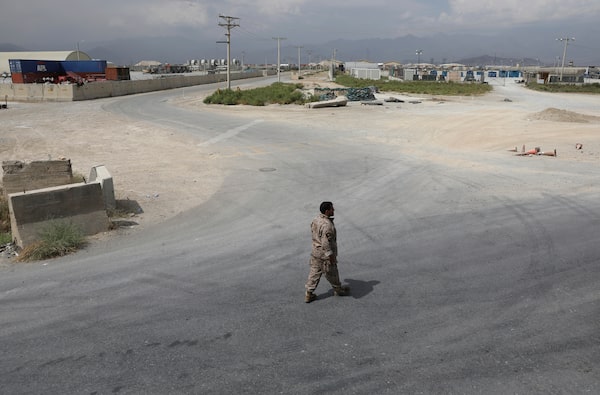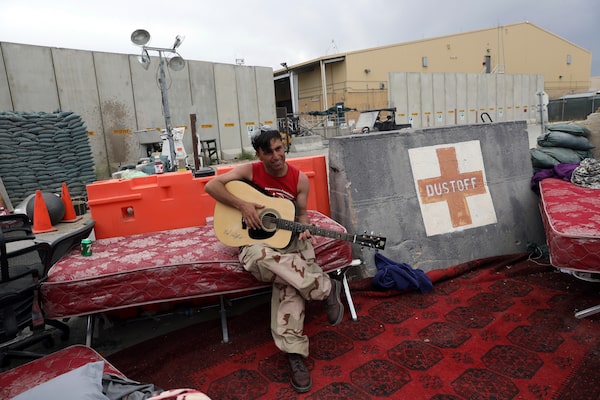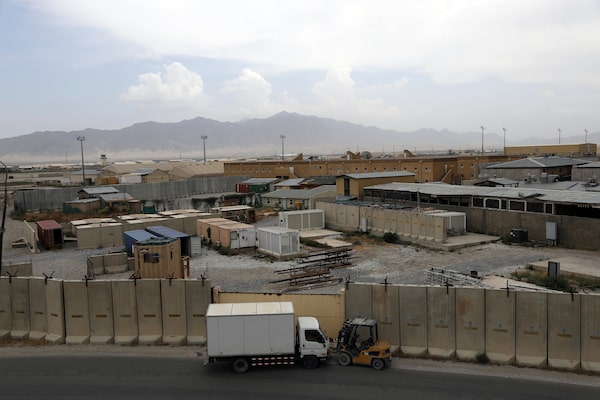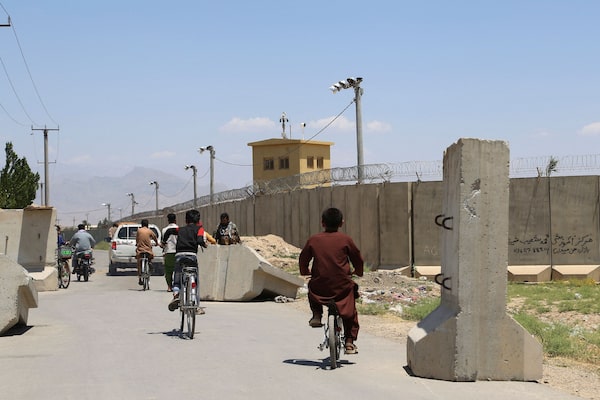
A member of the Afghan security forces walks in the sprawling Bagram air base after the American military departed, in Parwan province north of Kabul, Afghanistan, on July 5, 2021.Rahmat Gul/The Associated Press
Late in 2001, in the final weeks of Taliban rule in Afghanistan, I visited a bombed-out control tower at Bagram airport, where the Taliban were fighting the U.S.-backed Northern Alliance.
The airport was a jumble of wrecked equipment and ruined buildings, bullet-scarred and gutted. But even then, as now, it held immense strategic value to the armies of all sides.
In the daytime, Taliban tanks fired shells toward the airport, kicking up dust and smoke. At night, Northern Alliance soldiers huddled under blankets in the control tower and watched Bollywood movies, while their comrades on the observation deck counted the headlights of the Taliban vehicles in the distance.
For more than 40 years, Bagram has been a prize for superpowers and insurgents. But this month the United States finally abandoned its massive Bagram base, opening a new chapter in a long-contested country.
Canada working to resettle dozens of Afghan interpreters and staff facing retaliation from Taliban

An Afghan soldier plays a guitar that was left behind after the American military departed Bagram Airbase, north of Kabul, Afghanistan. The U.S. left Bagram after nearly 20 years without notifying the new Afghan commander until more than two hours after they slipped away into the night.Rahmat Gul/The Associated Press
First built in the 1950s as a civilian air field, about 70 kilometres north of Kabul, the airport gained crucial importance after the Soviet Union invaded Afghanistan in 1979. The Soviets turned Bagram into a key military site, a staging point for airborne troops and a base for their combat aircraft.
The Soviets withdrew from the country in 1989, leaving Bagram to the Afghans. By the late 1990s, the Taliban and Northern Alliance were at opposite ends of the airport, battling for possession of it.
In December, 2001, U.S. troops won control of the airport and soon expanded it into a sprawling military base for tens of thousands of U.S. personnel, civilian contractors and Afghan employees.
A second runway was added. Army tents were replaced by more comfortable barracks. The base featured a library, a post office, air-conditioned fitness centres and a range of dining facilities, including Burger King, Pizza Hut, Subway, Dairy Queen, Thai and Afghan restaurants and Green Beans Coffee shops.

DETAIL
CHINA
INDIA
AFGHANISTAN
PAKISTAN
0
55
KM
Bagram air base
Jalalabad
Kabul
Peshawar
Islamabad
AFGHANISTAN
PAKISTAN
THE GLOBE AND MAIL, SOURCE: TILEZEN; OPENSTREETMAP
CONTRIBUTORS

DETAIL
CHINA
INDIA
AFGHANISTAN
PAKISTAN
0
55
KM
Bagram air base
Jalalabad
Kabul
Peshawar
Islamabad
AFGHANISTAN
PAKISTAN
THE GLOBE AND MAIL, SOURCE: TILEZEN; OPENSTREETMAP
CONTRIBUTORS

DETAIL
0
55
KM
Bagram air base
AFGHAN.
PAKISTAN
Jalalabad
Kabul
Islamabad
Peshawar
AFGHANISTAN
CHINA
INDIA
PAKISTAN
THE GLOBE AND MAIL, SOURCE: TILEZEN; OPENSTREETMAP CONTRIBUTORS
Warplanes and cargo aircraft took off and landed at the airport around the clock as Bagram became the base for U.S. counterterrorism operations in Afghanistan. It was also the site of detention centres for thousands of prisoners, who were sometimes tortured by U.S. troops and Central Intelligence Agency interrogators, according to reports by government officials and human-rights groups.
In recent weeks, Bagram has become the base of a different operation: The U.S. withdrawal from Afghanistan. Hundreds of transport flights have departed from Bagram with massive quantities of U.S. weapons, military equipment and other supplies.

First built in the 1950s as a civilian air field, U.S. troops won control of the airport in December 2001, and soon expanded it into a sprawling military base for tens of thousands of U.S. personnel, civilian contractors and Afghan employees.Rahmat Gul/The Associated Press
An Afghan man rests in his shop near the now vacant Bagram U.S. Airbase.MOHAMMAD ISMAIL/Reuters
Last week, without any fanfare, the last remaining U.S. troops slipped away from Bagram during the night, leaving it in the hands of Afghan troops who will attempt to defend it from the Taliban again.
Soon after the U.S. pullout, the base’s electricity failed. Under cover of darkness, looters rampaged through the base, grabbing whatever they could take from barracks and tents, until the Afghan soldiers regained control.

Children ride bicycles past a road checkpoint outside of the recently vacated Bagram Airbase. Last week, without any fanfare, the last remaining U.S. troops slipped away from Bagram during the night, leaving it in the hands of Afghan troops who will attempt to defend it from the Taliban again.ZAKERIA HASHIMI/AFP/Getty Images
Our Morning Update and Evening Update newsletters are written by Globe editors, giving you a concise summary of the day’s most important headlines. Sign up today.
 Geoffrey York
Geoffrey York